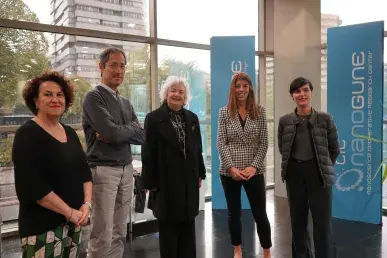CIC nanoGUNE and BIC Gipuzkoa strengthen ties to increase the social and economic impact of nanotechnology
At nanoGUNE this morning CIC nanoGUNE and BIC Gipuzkoa analyzed the outcomes of the collaboration between both organizations over the last four years. Jose Maria Pitarke, director of nanoGUNE, and Marisa Arriola, managing director of BIC Gipuzkoa, highlighted the success of the enhancement program to generate new innovation projects and new enterprises, and with respect to the four projects developed jointly, they predicted a significant economic and social impact of nanotechnologies applied to the biomedical sector.

The main aim of the work by BIC Gipuzkoa is to seek out and set up science and technology-based projects and enterprises in Gipuzkoa. So, “it is essential to nudge or drive forward technologies that are being developed at centers such as nanoGUNE to give them the final impetus they need to achieve this goal”, as Marisa Arriola, managing director of BIC Gipuzkoa pointed out.
BIC Gipuzkoa's enhancement program is based on jointly developing a development and transfer plan, incorporating in the analysis all those factors that a potential client or specialized investor would take into account; it is a way of identifying the exploitation strategy of all these projects and initiatives. The ultimate goal of this collaboration is to create new science and technology-based enterprises, or patent licensing so that a third party can exploit the intellectual property assets of centers such as nanoGUNE. It is a very competitive program in which nanoGUNE has managed to participate 4 times since the program was set up in 2018.
BIC Gipuzkoa's valorization program is based on jointly developing a development and transfer plan, incorporating in the analysis all those factors that a potential client or specialized investor would take into account; it is a way of identifying the exploitation strategy of all these projects and initiatives.
For its part, “nanoGUNE seeks support from organizations such as BIC Gipuzkoa to study the feasibility of its initiatives and to receive guidance and advice so that our projects will come to fruition. That way, we prioritize exploitation strategies and thus internal efforts”, said Jose Maria Pitarke, director of nanoGUNE. “For us, it's a perfect tool for facilitating technology transfer,” added Pitarke.
Nanotechnologies geared towards biomedical challenges
As a result of the collaboration between the two organizations, several technologies have been protected by patents. The first is the development of a new technology that enables babies to be delivered more safely. In this case, a new European patent application was filed in collaboration with Biodonostia to protect this highly innovative technology that has attracted investment interest from international biotechnology companies.
Secondly, a study was conducted to look at how to exploit Novaspider and in which sectors; it is a piece of 3D additive manufacturing equipment using nano- and microfibers. The analysis identified the health sector as a priority, and the strategy was reoriented towards that field. As a result, nanoGUNE is currently participating in the CardioPrint project with Novaspider; the aim is to make progress in the field of biofabrication by developing a novel device capable of generating bioartificial human tissue, such as myocardial tissue, with unprecedented precision.
A third enhancement study, this time into CRISPR technology for gene editing, identified amyotrophic lateral sclerosis (ALS) associated with mutations in several genes as an area of potential application. The strategy for modifying the genes responsible for ALS undoubtedly offers one of the best hopes for treating this disease. So, the CRISPR gene editing technology provides tools to address this strategy. Acting like a pair of molecular scissors, CRISPR technology is able to cut and paste pieces of genetic material into any cell. This technology is also protected by a patent application.
A last project, recently completed, explored the potential fields of application of a method for monitoring physiological parameters in vitro. The analysis focused more specifically on the potential areas of exploitation in the field of Alzheimer's diagnosis, where it is considered to be of tremendous use.
